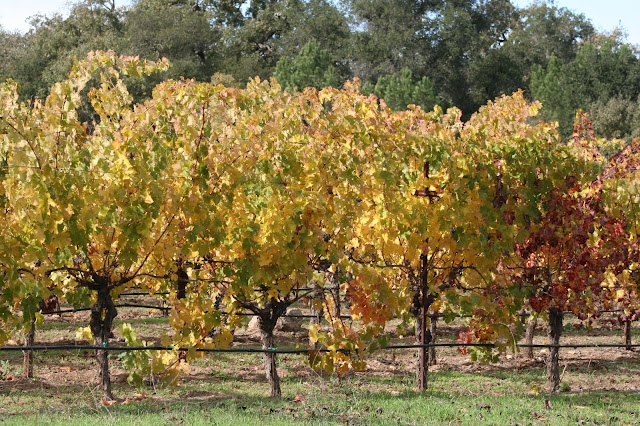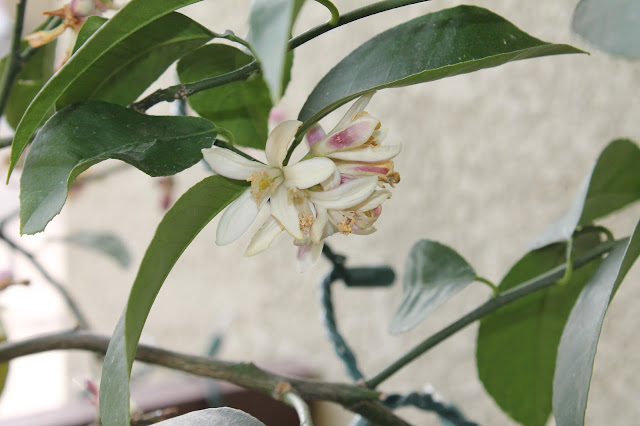 |
| You know it's Fall when the grape vines change from green to gold. |
Spring, Summer, and Fall the weather is so stable, except for the occasional hot summer days that push into the 90's, the average daytime temperature is in the 70's to low 80's and it quickly drops into the 60's once the sun sets in the evening. Humidity is rare, as is rain.
 |
| On December 9th, this tree still had plenty of green leaves. |
The glorious red and orange colors of New England are rare here, although sugar maples and other trees that provide brilliant fall colors have found their way to nurseries here and do pop up here and there.
Still, while deciduous trees do turn color and shed their leaves, the prevailing color here is gold with occasional pops of orange.
Late into November, this tree was still mostly green. It finally dropped its leaves just before Christmas.
I love the orange colors on some of the trees. When the sun is shining, it almost seems as though the trees are on fire!
The other striking difference between New England and the Napa Valley is that while things are turning brown in the Northeast's winter landscape, the rains turn the hills green as fresh new growth replaces the brown grass and brush that gradually dried out and went dormant over the dry summer.
Looking out at the hills behind our apartment, the golden swaths of grapevines in the vineyards contrast with the fresh grass in the bright green fields and pastureland.
 |
| The hills behind our apartment... starting to green up with the recent rain. |
The rains gradually increase through the Fall but Winter is the rainy season and we get roughly 85% of the annual 20'1/2 inches of average rainfall between November and March. Both rainwater and melting snow from the snow packs in the mountains refill the aquifers and provide the groundwater used for irrigation during the growing season.
For the last four years, the winter rain has been abysmally low resulting in a lengthy and worrisome drought. Last year was exceedingly dry but the December 2014 rainfall at 11.03 inches (almost 3 times our usual December rainfall) helped to avert disaster when the January rains, usually the highest amount of rainfall for the year, simply never came.
But we are off to a better start this year. Ordinarily, we get about 2.5 inches of rain in November and 3.8 inches of rain in December. So far this winter, we have received a decent amount of rain: almost 2 inches for November and a respectable 2.8 inches to date this month.
But even better for the long term outlook is that many of the recent storms skidded past us, leaving a scant half inch or less of rain behind and instead carrying the water inland where it was deposited in the form of snow in the mountains.
The Sierra Nevadas now boast a 10 foot snow pack, double what is usually accumulated this early in the season. In fact, ski resorts opened weeks ahead of schedule with natural, not man-made snow. With a strong el nino predicted to give us an exceptional amount of rain over the next two months, we may reach our annual average and make up some of the deficit of the previous three years. And if the snow pack in the mountains continues to benefit from Mother Nature's munificence, we may be in good shape when the rains roll out and April rolls in.
But I'm still having some trouble getting used to "Winter" in the valley, where Christmas lights are draped over a blooming lemon tree and snake through window boxes full of blooming annuals that would have long since perished in the hard New England frosts.
 |
| The lemons are ripe and the lemon tree is in full bloom, as are the snapdragons in the window box. |
 |
| Chanukah, 2015 with a Boston Fern thriving outdoors -- not in Boston! |
 | ||||
| Chanukah lights weaving through blooming annuals and the lemon tree. |
Outside, the sky was bright blue, the sun was shining, and the temperature was a balmy 66 degrees.
I waited patiently but the promised rain didn't materialize and so just shy of 4 PM I got ready to walk the dogs over to the park where we usually get our afternoon exercise. As I was getting a sweater and leashes, I heard what sounded like thunder claps and then the living room suddenly became dark.
When I looked out, I was shocked to see a fast-moving storm had blown in. Lightening joined the thunder and torrential rain broke through the clouds and gave way to pelting hail. The storm barely lasted an hour but dropped just over a half inch of new rain on the sun parched earth. It moved out as quickly as it moved in and when the sun finally poked back through the clouds, the temperature was a brisk 51 degrees F.
 |
| The storm moved in quickly and the blue sky disappeared under the roiling gray clouds. |
 |
| This was the angriest cloud and the backdrop for much of the lightening. |
 |
| Just as quickly as the clouds rolled in, they blew out and to the east. |
We are finally registering the typical winter temperatures usually seen in this climate for this time of year. Mid to high 30's into the low 40's at night, high 50's into the low 60's during the day. We've had rain on and off throughout the last 8 weeks but rarely more than several hours at a time. Many of those days, it rained heavily overnight but the sun rose to clear skies.
We close out 2015 with blue skies, brisk temperatures in the mid-50's, and the prospect of generous rainfall over the next 8 weeks from an enthusiastic el nino. That would indeed be a Happy New Year.

























